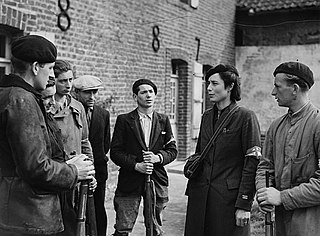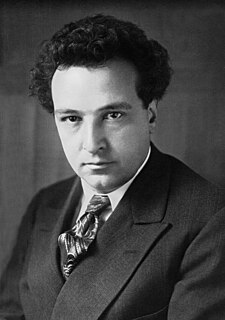
The Arc de Triomphe de l'Étoile is one of the most famous monuments in Paris, France, standing at the western end of the Champs-Élysées at the centre of Place Charles de Gaulle, formerly named Place de l'Étoile — the étoile or "star" of the juncture formed by its twelve radiating avenues. The location of the arc and the plaza is shared between three arrondissements, 16th, 17th (north) and 8th (east). The Arc de Triomphe honours those who fought and died for France in the French Revolutionary and Napoleonic Wars, with the names of all French victories and generals inscribed on its inner and outer surfaces. Beneath its vault lies the Tomb of the Unknown Soldier from World War I.

The Maquis were rural guerrilla bands of French Resistance fighters, called maquisards, during the Nazi Occupation of France in World War II. Initially, they were composed of men and women who had escaped into the mountains to avoid conscription into Vichy France's Service du travail obligatoire to provide forced labor for Germany. To avert capture and deportation to Germany, they became increasingly organized into active resistance groups.
A resistance movement is an organized effort by some portion of the civil population of a country to withstand the legally established government or an occupying power and to disrupt civil order and stability. It may seek to achieve its objectives through either the use of nonviolent resistance, or the use of force, whether armed or unarmed. In many cases, as for example in Norway in the Second World War, a resistance movement may employ both violent and non-violent methods, usually operating under different organizations and acting in different phases or geographical areas within a country.

Arthur Honegger was a Swiss composer, who was born in France and lived a large part of his life in Paris. He was a member of Les Six. His most frequently performed work is probably the orchestral work Pacific 231, which was inspired by the sound of a steam locomotive.
The National Front was a World War II far-left French Resistance movement, created in 1941 by Jacques Duclos and Pierre Villon, both members of the French Communist Party (PCF). Its name was inspired by the Popular Front, a left-wing coalition which governed France from 1936 to 1938.

Brive-la-Gaillarde is a commune of France. It is a sub-prefecture of the Corrèze department. It has around 50,000 inhabitants, while the population of the urban area was 89,260 in 1999.
Resistance movements during World War II occurred in every occupied country by a variety of means, ranging from non-cooperation, disinformation and propaganda, to hiding crashed pilots and even to outright warfare and the recapturing of towns. In many countries, resistance movements were sometimes also referred to as The Underground.

The French Forces of the Interior refers to French resistance fighters in the later stages of World War II. Charles de Gaulle used it as a formal name for the resistance fighters. The change in designation of these groups to FFI occurred as France's status changed from that of an occupied nation to one of a nation being liberated by the Allied armies. As regions of France were liberated, the FFI were more formally organized into light infantry units and served as a valuable manpower addition to regular Free French forces. In this role, the FFI units manned less active areas of the front lines, allowing regular French army units to practice economy of force measures and mass their troops in decisive areas of the front. Finally, from October 1944 and with the greater part of France liberated, the FFI units were amalgamated into the French regular forces continuing the fight on the Western Front, thus ending the era of the French irregulars in World War II.

The Belgian Resistance collectively refers to the resistance movements opposed to the German occupation of Belgium during World War II. Within Belgium, resistance was fragmented between a large number of separate organizations, divided by region and political stances. The resistance included both men and women from both Walloon and Flemish parts of the country. Aside from sabotage of military infrastructure in the country and assassinations of collaborators, these groups also published large numbers of underground newspapers, gathered intelligence and maintained various escape networks that helped Allied airmen trapped behind enemy lines escape from German-occupied Europe.

The Provisional Government of the French Republic was an interim government of Free France between 1944 and 1946 following the liberation of continental France after Operations Overlord and Dragoon, and lasted until the establishment of the French Fourth Republic. Its establishment marked the official restoration and re-establishment of a provisional French Republic, assuring continuity with the defunct French Third Republic.
The National Council of the Resistance, in French Conseil National de la Résistance (CNR), was the body that directed and coordinated the different movements of the French Resistance - the press, trade unions, and members of political parties hostile to the Vichy regime, starting from mid-1943.

The Romanian anti-communist resistance movement was active from the late 1940s to the mid-1950s, with isolated individual fighters remaining at large until the early 1960s. Armed resistance was the first and most structured form of resistance against the communist regime, which in turn regarded the fighters as "bandits". It wasn't until the overthrow of Nicolae Ceauşescu in late 1989 that details about what was called "anti-communist armed resistance" were made public. It was only then that the public learnt about the several small armed groups, which sometimes termed themselves "haiducs", that had taken refuge in the Carpathian Mountains, where some hid for ten years from authorities. The last fighter was eliminated in the mountains of Banat in 1962. The extent and influence of the movement is often exaggerated in the post-Communist Romanian media, memoirs of the survivors and even historiography, while the authoritarian, anti-Semitic and/or xenophobic ideology of part of the groups is generally overlooked or minimized. The Romanian resistance is sometimes claimed to be one of the longest lasting armed movements in the former Soviet bloc.

Vassieux-en-Vercors is a commune in the department of Drôme in southeastern France.
"Ceux de la Libération" (CDLL) was a French resistance movement during the German occupation of France in World War II.

This combat structure is the result of the regrouping of the paramilitary formations of the three most important "Gaullist" resistance movements in the southern zone: Combat, Libération-Sud and Franc-Tireur.
Libération-Nord was one of the principal resistance movements in the northern occupied zone of France during the Second World War.

Italian-occupied Corsica refers to the military occupation by the Kingdom of Italy of the island of Corsica during World War II. It lasted from November 1942 to September 1943.
When Luxembourg was invaded and annexed by Nazi Germany in 1940, a national consciousness started to come about. From 1941 onwards, the first resistance groups, such as the Letzeburger Ro'de Lé'w or the PI-Men, were founded. Operating underground, they secretly worked against the German occupation, helping to bring political refugees and those trying to avoid being conscripted into the German forces across the border, and put out patriotic leaflets encouraging the population of Luxembourg to pull through.











